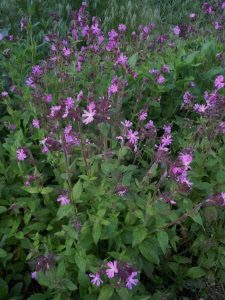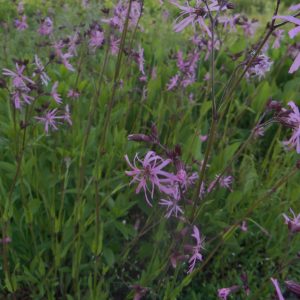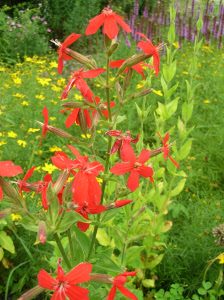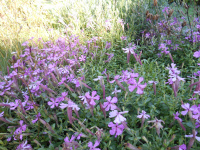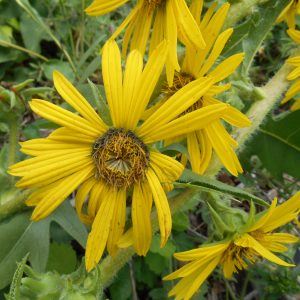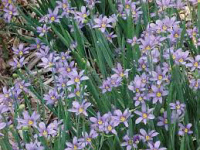Our Plants
Showing 537–544 of 616 results
-
Silene coronaria syn. Lychnis coronaria Rose campion Z 4-8
Bright crimson/magenta 5-round-petaled flowers contrast felted silvery-white foliage in early to midsummer. Be sure to let it drop its seeds for more plants next year or the year after.
Bright crimson/magenta 5-round-petaled flowers contrast felted silvery-white foliage in early to midsummer. Be sure to let it drop its seeds for more plants next year or the year after.
Size: 24" x 18"
Care: Full sun in moist well-drained to well-drained soil
Native: Southeastern Europe
Awards: England's Royal Horticultural Society Award of Merit.Lychnis named by Theophrastus in the 3rd century B.C. for “lamp” believed to be because the downy leaves were used to make lamp wicks, but some say due to the flame-colored flowers. Mythology reports that the Rose campion sprang from the bath of Aphrodite. Rose campion has been in European garden cultivation since the 1300’s. Parkinson in 1629 wrote of the Rose campion: “The single red Rose campion hath divers thick, hoary or woolly long greene leaves, abiding greene all the winter, and in the end of the spring or beginning of summer, shooteth forth two or three hard round woolly stalkes, with some joints thereon, and as every joint two such like hoary greene leaves as those below, but smaller, diversly branched at the toppe, having one flower upon each severall long stalke … of a perfect red crimson colour …” Paradisi in Sole Paradisus Terrestris. Both George Washington and Thomas Jefferson grew this plant. (Jefferson in 1807.)
-
Silene dioica Red Campion Z 5-8
Dark pink-purple flowers from late spring to mid-summer
Dark pink-purple flowers from late spring to mid-summer
Size: 32” x 18”
Care: full sun to part shade in moist well-drained soil
Native: Europe
Wildlife Value: a favorite of BumblebeesIn Greek mythology Silene was a companion of Bacchus who was covered with foam. Dioicus means that male and female plants are separate. Described by 1750’s. Grown in American gardens since 1800’s
-
Silene flos-cuculi syn. Lychnis flos-cuculi Ragged robin Z 4-9
May-June, cotton-candy pink star shaped of thin petals as if a bursting star.
May-June, cotton-candy pink star shaped of thin petals as if a bursting star.
Can not ship to: Connecticut and Maryland.
Size: 30” x 32”
Care: Sun to part shade, moist well-drained soil
Native: Europe, Caucasus, Russia
Wildlife Value: Butterfly plant, attracts Small Pearl Bordered Frilillary and Common BlueFlos is Latin for “flower.” According to Parkinson (1629) Ragged robin was used to cure wounds as early as Roman times. Grown by Washington at Mount Vernon. In 1851 Breck called the Ragged robin “an old inhabitant of the flower garden.”
-
Silene regia Royal catchfly Z 5-8
True crimson stars, brighter than a stop light
OUT OF STOCK
True crimson stars, brighter than a stop light, in July – September, from the prairies.
Size: 2-3’ x 1-2’
Care: sun to part shade in moist well-drained soil
Native: from Ohio to Alabama W. to Nebraska, WI native
Wildlife Value: hummingbird favorite.In Greek mythology Silene was a companion of Bacchus who was covered with foam. French plant hunter Andre Michaux may have been the 1st to collect this c. 1800. Grown from seed collected by English planthunter Thomas Nuttall (1786-1859) near St. Louis on the Mississippi River c. 1812.
-
Silene schafta Schaft’s catchfly, Moss Z 5-7
One of the spectacular late season blooms –clusters of five-petaled, jagged-edge, bright magenta flowers on short mounds, September to October. Perfect for front of borders or rock gardens.
OUT OF STOCK
One of the spectacular late season blooms –clusters of five-petaled, jagged-edge, bright magenta flowers on short mounds, September to October. Perfect for front of borders or rock gardens.
Size: 6” x Slowly spreading
Care: full sun in well-drained to moist well-drained soil
Native: Russia
Awards: England’s Royal Horticultural Society Award of MeritIntroduced from its native Russia in 1844. First described by and probably collected by Johann Gmelin (1709-1755) German naturalist who spent years hunting plants in Russia and authored four-volume Flora Sibirica. In Greek mythology Silene was a companion of Bacchus who was covered with foam. William Robinson, father of the mixed perennial border, described the flowers of this species as being “very neat tufts.”
-
Silphium laciniatum Compass plant Z 4-9
Tall, sunflower-like plant with big, deeply lobed, hairy leaves, that move north and south to follow mid-day sun. Two to five inch wide, sunny-yellow daisies grow at intervals along the top half of the stiff, square, sticky stem from mid-summer into fall.
OUT OF STOCK
Tall, sunflower-like plant with big, deeply lobed, hairy leaves, that move north and south to follow mid-day sun. Two to five inch wide, sunny-yellow daisies grow at intervals along the top half of the stiff, square, sticky stem from mid-summer into fall.
Size: sun to part shade in moist to well-drained soil with its deep taproot
Care: 6- 12’ x 24”
Native: East and central U.S. as far west as the Great Plains, Wisconsin native
Wildlife Value: pollinated by bumblebees, Miner bees, large leaf Cutting and solitary bees, Goldfinches feast on the seeds in fall.
Awards: Missouri Botanic Garden Plant of MeritNatives chewed the plant’s sap like chewing gum. Lakota Sioux made an infusion of the plant is used to deworm horses and humans of and to break up congestion in the lungs. Grew in Bartram’s colonial nursery by 1770’s. Grown at America’s 1st botanic garden, Elgin Botanic Garden 1811.
Named “Compass plant” for its leaves move, facing north and south.
-
Silphium perfoliatum Cup plant Z 3-9
Golden daisies waive at the sun from July to September, its cup shaped leaves hold water where butterflies drink & bathe
Golden daisies waive at the sun from July to September, its cup shaped leaves hold water where butterflies drink & bathe
Can not ship to: Connecticut and New York
Size: 7’ x 3’
Care: full sun to part shade in moist soil
Native: Central North America, native to Wisconsin.
Awards: England’s Royal Horticultural Society Award of MeritSap used by Native Americans to chew and freshen breath. Also used to cure colds, neuralgia, fever, and liver disorders. The Chippewa used to stop lung hemorrhaging, menstrual bleeding and cure chest pain. The Winnebago drank a potion from the plant to purify themselves before a buffalo hunt. For the Iroquois it cured paralysis, prevented children from seeing ghosts and illness caused by the dead. Lakota Sioux: “Children sometimes use the resin as chewing gum. An infusion of the whole plant is used to rid horses and humans of intestinal worms. An infusion of the leaves is used to loosen phlegm in the lungs. Described and classified in 1753.
-
Sisyrinchium angustifolium Blue eyed grass Z 3-9
Cutest petite iris-like foliage sporting blue saucer-shaped flowers with bright yellow stamens in summer.
Cutest petite iris-like foliage sporting blue saucer-shaped flowers with bright yellow stamens in summer.
Size: 12" x 6"
Care: Sun in well-drained soil
Native: North America, Wisconsin native.In cultivation by 1732. Named by Philip Miller, gardener of the Chelsea Botanic Garden, in Gardeners’ Dictionary .
Mahuna Indians of So. California made a tea from the entire plant to expel stomach worms.


